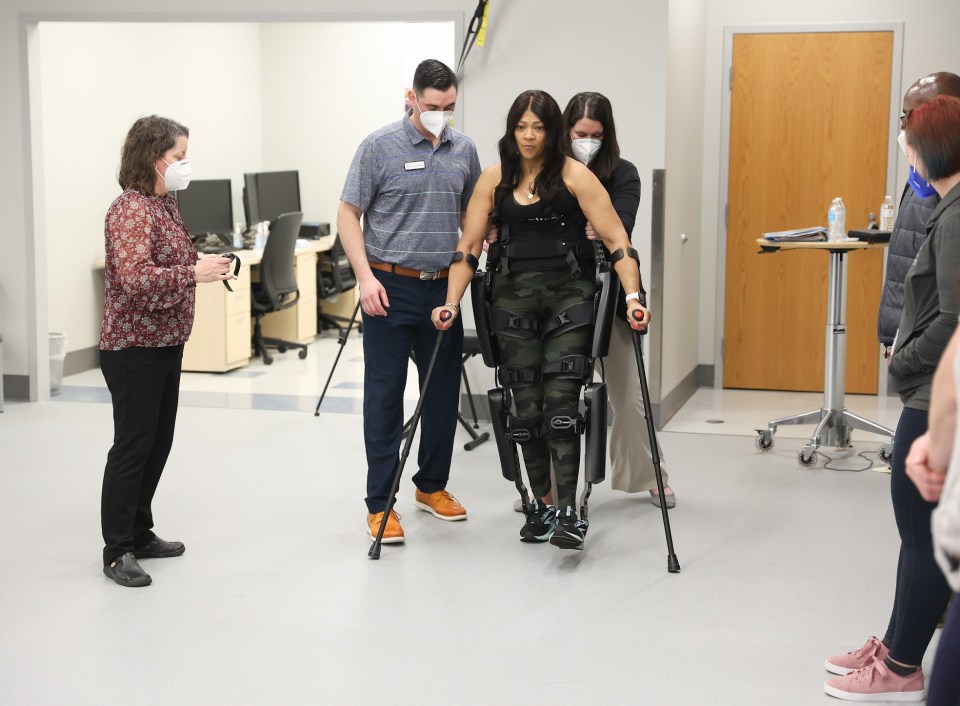The human spine or vertebral column supports the body’s physical structure and nervous system, enabling movement and sensation. In addition to vertebrae, the spine contains facet joints, intervertebral discs, nerves and soft tissue.
The thoracic spine lies in the upper and middle back region, starting at the base of the neck and extending to the bottom of the rib cage. It contains 12 stacked vertebrae, numbered T1 to T12. It supports your chest and abdomen and protects the heart and lungs. A thoracic spine fracture, or a break, is classified by the specific pattern of the fracture and whether there is spinal cord injury.
Most Common Types of Spine Fracture Patterns
There are three main types of thoracic spine fractures: flexion, extension and rotation fractures.
Flexion Fracture Pattern
- Compression fracture. Compression fractures are typically caused by osteoporosis and occur later in life. The front of the vertebra breaks but the back, or posterior, portion of the vertebra remains intact. This type of fracture is usually stable and typically doesn’t cause neurological problems.
- Axial burst fracture. Axial overload of the spine can be caused by a high-energy fall where you land on your feet. An axial burst fracture causes damage to both the front (anterior) and back (posterior) portion of the vertebra. This type of fracture may be stable or unstable, meaning the bones have shifted out of place. Nerve compression may or may not be present.
Extension Fracture Pattern
Also known as a flexion/distraction fracture, this type of fracture is usually the result of a head-on car collision. If you are wearing a seatbelt, your upper body is thrust forward while your lower body remains in place causing the vertebra to separate and break. In most cases, the fracture is unstable and may separate completely or move out of place. You may even experience spinal cord injury.
Rotation Fracture Pattern
- Transverse process fracture. Each of the spinal vertebra have two wing-like structures that extend off the sides of the spine. A forceful impact from a car collision, sports injury, severe bending or twisting motion, blow to the back or other trauma, can cause the muscle that attaches to these wings to contract so forcefully that it pulls off a chip of bone from the spinal. It does not cause instability or spinal cord injury but may result in internal bleeding.
- Thoracic fracture-dislocation. These rare but serious injuries are caused by high-energy trauma. The entire vertebra is broken from front to back severely enough that it moves back and forth or side-to-side. This causes instability and often results in spinal cord injury.
Causes of Thoracic Spine Fracture
If you have a thoracic spine fracture that occurred due to trauma, you may also have other serious injuries that require immediate attention. Causes include:
- Acute trauma such as a high-speed car accident, sports injury or a fall from a tall height
- Osteoporosis that weakens the bone making it susceptible to fracture
- Pathological changes such as a tumor that destroys bone tissue
Recognizing Symptoms of Thoracic Spine Fractures
Back pain following trauma should be evaluated for a spine fracture. If you have osteoporosis and experience a sudden onset of back pain, spinal fracture should also be considered. Symptoms of thoracic spine fractures vary depending on whether there is nerve damage but include some or a combination of the following:
- Immediate pain, swelling and tenderness after an injury
- Sudden onset of back pain that may be severe
- Back pain that worsens with movement
- Limited movement of the spine
- Deformity or disability in the form of thoracic kyphosis, a forward curving of the spine
- Weakness or numbness in the back, arms or legs
- Breathing difficulty
- Loss of bladder or bowel control
Diagnosing Thoracic Spine Fractures
There are several steps involved in diagnosing a thoracic spine fracture. If the fracture is due to a traumatic event, other injuries may be involved. If you are suspected to have a spinal injury following an accident, emergency stabilization is needed. This includes placement of a cervical neck collar and transfer to a backboard. Steps toward diagnosing this type of injury could include:
- A head-to-toe physical examination to determine the cause of pain and rule out certain problems
- Evaluation of your neurological status, which involves testing your ability to move, feel and awareness of limb position
- Testing your reflexes
- X-rays
- Computed tomography (CT) scan
- Nuclear bone scan to identify osteoporosis
- Electromyogram (EMG), which measures the speed of electrical impulses moving through your nerves and muscles
- Myelogram, an imaging test that is used to record detailed images of your spine
Treatment Options for Thoracic Spine Fractures
There are two approaches for the management and treatment of thoracic spine fractures: Non-surgical and surgical.
- Surgical management. Unstable fractures that are severe may require a laminectomy. A laminectomy is performed through an incision on your side or back. The bony arch on the back of the spinal canal is removed along with any other structures that are pushing on the spinal cord. The damaged bone is reconstructed, or screws are placed above and below the fracture to provide stabilization..
- Non- surgical management. Rehabilitation through physical and occupation therapy.
Complications of Thoracic Spine Fractures
Many of the complications associated with thoracic spine fractures are related to lack of mobility and restricted movement. They include blood clots in the pelvis and legs, pulmonary embolism—a blood clot that moves through the bloodstream to the lungs—pneumonia and pressure sores.
Surgical complications include:
- Bleeding
- Wound infection
- Failure of the vertebra to fuse together after surgery
- Blood clots
- Spinal fluid leaks
- Weakness in both legs
Rehabilitation
Both non-surgical and surgical treatment for thoracic spine fractures require rehabilitation. Following a spinal fracture there are certain measures you can adopt that may protect your spine and reduce the pain felt during the healing process. Your doctor may recommend inpatient or outpatient physical therapy to:
- Return to daily activities. Rehabilitation can help you return as closely as possible to your normal pre-injury activities.
- Pain reduction. Many different treatments, technologies and hands-on therapy can be adopted to control and reduce your pain. These treatments can help you avoid the need for pain medications, including opioids.
- Movement guidance: Physical therapists will teach you what movements and exercises to gently perform and what not to perform. Avoiding certain movements will promote healing and help prevent future fractures or collapse of the vertebrae.
- Flexibility. Flexibility exercises can range from gentle spinal range-of-motion exercises.
- Strengthening: Gradual progression to gentle exercises can help stimulate your bone strength and straighten the curve of your middle back.
- Posture and spine sparing: Maintaining a safe posture and spinal positions plays an important role in managing spinal fractures and helps prevent post-fracture complications. This will protect the vertebrae from stress when you sit, stand, walk and even while you sleep. You also will learn proper ways to perform tasks at home, such as bending and lifting.
- Fall prevention. A physical therapist works to improve your balance and steady your walking to prevent falls. You may be instructed in how to use a walker or cane for temporary support as you recover.
- Home and environmental modification. A home safety assessment could be conducted to see if any modifications need to be made. Installation of grab bars, hand-held shower, raised toilet seats and walk-in showers are some of the home modifications that are usually recommended after a spine fracture.
- Home exercise program. A personalized home-exercise program helps to maintain the effects and benefits of rehabilitation.
The Role of Inpatient Rehabilitation
If you have sustained a spinal cord injury because of a thoracic spine fracture, inpatient rehabilitation may be recommended. You may experience lower body weakness, paralysis or reduced/lost sensation. A multi-faceted approach using advanced technologies is needed, along with a customized rehabilitation plan.
Inpatient rehabilitation offers a comprehensive rehabilitation program that includes physical therapy, occupational therapy and speech therapy (If applicable).
The overall goal of rehabilitation is functional restoration of your health to enable participation in your community and life. The focus is to improve the overall quality of life and regaining your independence.
References
- Kisner & Colby, Therapeutic exercises
- Rehabilitation of the spine: A practitioner’s manual : Craig Liebenson
- Rehabilitation after Traumatic Fracture of Thoracic and Lumbar Spine]: Z Orthop Unfall; 2018 Oct;156(5):533-540.
- Spinal Compression Fracture Management: A Review of Current Treatment Strategies and Possible Future Avenues; Ivo K. Genev1,Matthew K. Tobin1, Saher P. Zaidi1 Sajeel R. Khan1 Farid M. L. Amirouche2 Ankit I. Mehta1; Global Spine J; 2017
The content of this site is for informational purposes only and should not be taken as professional medical advice. Always seek the advice of your physician or other qualified healthcare provider with any questions you may have regarding any medical conditions or treatments.



